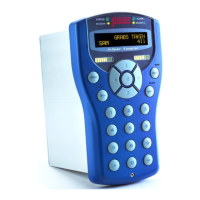This produces the natural log for the value of register F_USER_FLOAT1.
11.13.3 POW EXAMPLE
F_USER_FLOAT2=POW(F_USER_FLOAT3, F_USER_FLOAT4);
This raises F_USER_FLOAT3 to the power F_USER_FLOAT4. These are floating power
powers and so can also be used in the calculation of roots, a square root would be to the power 0.5
11.13.4 SIN EXAMPLE
F_USER_FLOAT2=SIN(F_USER_FLOAT1);
This calculates the sin of F_USER_FLOAT1, where F_USER_FLOAT1 is measured in radians.
11.13.5 COS EXAMPLE
F_USER_FLOAT2=COS(F_USER_FLOAT1);
This calculates the cosine of F_USER_FLOAT1, where F_USER_FLOAT1 is measured in
radians.
11.13.6 TAN EXAMPLE
F_USER_FLOAT2=TAN(F_USER_FLOAT1);
This calculates the tangent of F_USER_FLOAT1, where F_USER_FLOAT1 is measured in
radians.
11.13.7 ASIN EXAMPLE
F_USER_FLOAT2=ASIN(F_USER_FLOAT1);
This calculates the inverse sin (arcsin) of F_USER_FLOAT1, where the result
F_USER_FLOAT2 is measured in radians.
11.13.8 ACOS EXAMPLE
F_USER_FLOAT2=ACOS(F_USER_FLOAT1);
This calculates the inverse cosine (arccos) of F_USER_FLOAT1, where the result
F_USER_FLOAT2 is measured in radians.
11.13.9 ATAN EXAMPLE
F_USER_FLOAT2=ATAN(F_USER_FLOAT1);
This calculates the inverse tangent (arctan) of F_USER_FLOAT1, where the result
F_USER_FLOAT2 is measured in radians.
11.13.10 RAND EXAMPLE
I_USER_INT1=RAND(1000);
This produces a random number between 0 and 999.
11.14 Operators Decision Making (? :)
This operator varies from every other, because it takes three arguments. If the first argument evaluates
to TRUE, then the second argument is returned, otherwise it returns the third argument.
<variable> = <evaluation> ? <expression if true> : <expression if false> ;
Example
i_ispare2 = i_ispare2 + 1;

